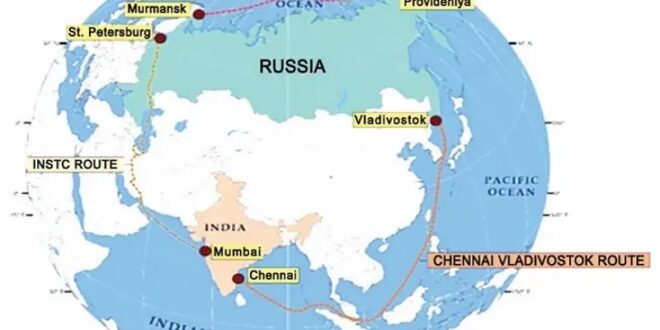The Kremlin’s intentions in building the “Russo-Indo Ring” around the Asian half of Eurasia are to promote friendly, gentle, and non-hostile Sino-Indo geo-economic competition aimed at accelerating equitable development and multipolar integration in this space.
The inaugural Russia-India workshop for Operationalization of the Eastern Maritime Corridor (EMC) took place in Chennai last week and is shaping up to the be the next big thing in bilateral relations. These two Great Powers’ success in reviving the previously dormant North-South Transport Corridor (NSTC) through Iran coupled with the Red Sea Crisis imbued their latest efforts with a heightened sense of urgency. Upon operationalization and optimization, the EMC is poised to become one of Eurasia’s top corridors.
RT reported that the parties are even exploring its expansion into the Northern Sea Route to create a seamless Indo-Pacific-Arctic trade corridor, which will first be used to scale mutual trade (mostly Russian resource exports to India) prior to possibly facilitating Indian-European trade. That last-mentioned phase of their plans will probably rely entirely on maritime transit via Russia’s Arctic waters for the foreseeable future, however, due to Western sanctions complicating third-parties’ trade via Russia’s railways.
Nevertheless, the EMC’s grand strategic importance is that it complements the NSTC to create what can be described as a “Russo-Indo Ring” around the Asian half of Eurasia. The EMC could also branch into Mongolia for scaling that country’s trade with India while the NSTC’s branches into Afghanistan and Central Asia will consolidate Indian influence there. The end result is that India is relying on Russia-backed geo-economic means for balancing China’s influence in the Eurasian Heartland.
During last October’s BRI Forum, “Putin Suggested That Chinese & Indian Investments In Russia Advance Shared Multipolar Goals”, which led to the conclusion that “Russia’s Sino-Indo Balancing Act Has An Increasingly Important Infrastructure Component”. Two months later, “Russia’s Top Asian Policymaker Shared Updates About The Greater Eurasian Partnership”, which indirectly touched upon the aforesaid balancing act. Readers can review the preceding analyses for more insight if they’re interested.
They argue that the Kremlin’s intentions in building the “Russo-Indo Ring” around the Asian half of Eurasia are to promote friendly, gentle, and non-hostile Sino-Indo geo-economic competition aimed at accelerating equitable development and multipolar integration in this space. Everyone benefits from truly free and fair competition of the kind that Moscow is encouraging, and nobody can suspect it of pursuing ulterior motives due to its equally important strategic partnerships with Beijing and Delhi.
The new priority given to the EMC proves that these two Great Powers recognize one another as integral to their respective and complementary grand strategies. Their interests align in the Indo-Pacific just like they do in the Eurasian Heartland and even the Arctic, with all three of these regions converging via that corridor and the NSTC to create a “Russo-Indo Ring” around the Asian half of the supercontinent. It’ll still take time to reap the strategic dividends, but nobody should doubt that they’ll be bountiful.
 Eurasia Press & News
Eurasia Press & News


